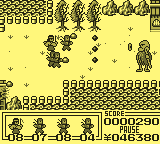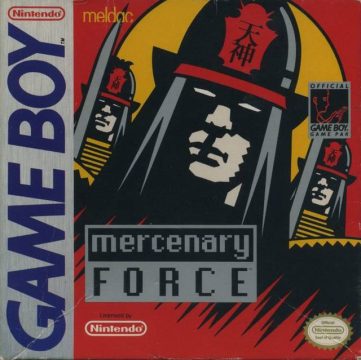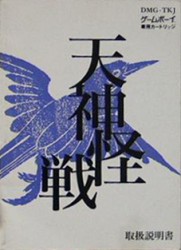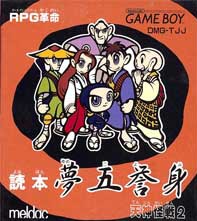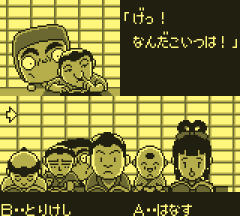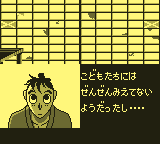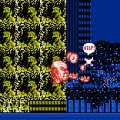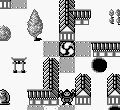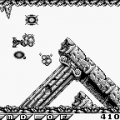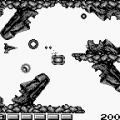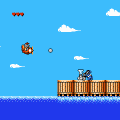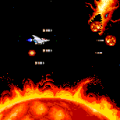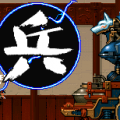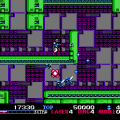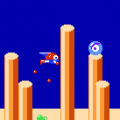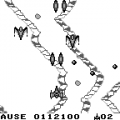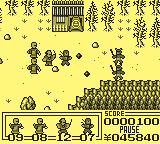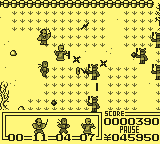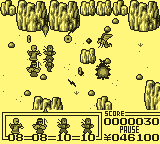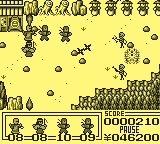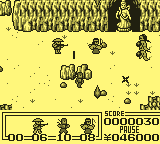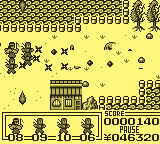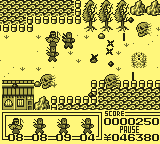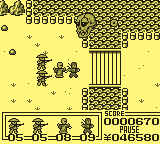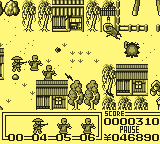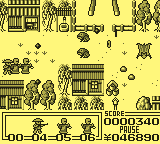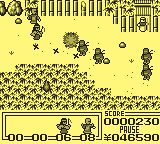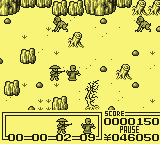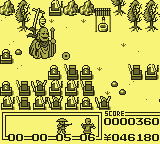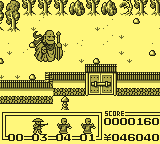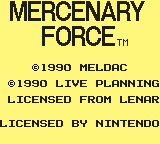Mercenary Force is a 2D hori shmup for the monochrome Game Boy. It falls under the same broad classification of forced horizontal scrollers such as R-Type, Gradius and the alternating stages of Axelay. The oriental styling might also warrant Sengoku Blade in that list. Mercenary Force‘s mechanics though are unlike any of the above – in fact, it’s hard to think of any shmups, hori or otherwise, which share similarities with it. Browsing the Shmups.com forums brings up comparisons to obscure titles like Final Zone on the MSX, but otherwise not much else. Its uniqueness in turn makes its obscurity all the more disappointing. For a genre which has been marginalized by the mainstream, resulting in fewer and less bombastic releases, plus an overall stagnation in the few which are released annually, those titles which do something different deserve examination – regardless of age. Mercenary Force might be over 20-years-old, but it still provides a unique experience and deserves our attention.
It was brought to us by a trio of obscure Japanese companies: Meldac, Live Planning and Lenar. Specifics relating to who developed and who published what are difficult to come by, but these three companies were jointly involved in the development and publishing of several obscure releases, including Heiankyo Alien and Battle of Kingdom, both on the Game Boy.
The basic premise is that you must hire four mercenaries out of a possible five and have them march through 6 stages of bullet-spewing hell in medieval Japan. According to the manual, each stage is made up of 12 screens. The visuals, though tiny, are steeped in Japanese mysticism and are reminiscent of the Ganbare Goemon games, with tiny jumping umbrella demons, swaggering oni, and so on. It’s not quite Muramasa, but if you appreciate this kind of cultural source material, it’s quite beautiful. The music, meanwhile, is bloody catchy throughout. There’s only a handful of tunes, but they’re all fantastic. If you listen to the first stage’s music, and strain your face like after eating too much matzo, there’s a short section which almost sounds like Yuzo Koshiro’s main tune from Legacy of the Wizard. Almost. It’s nice to see that when released in the west, there wasn’t any attempt to censor Mercenary Force‘s cultural origins, and because of this it exists in a special sub-category alongside games such as Pocky and Rocky, Mystical Ninja and Otogi.
Manual text taken from Shmups.com:
Over one hundred years ago during the mighty Shogun era, the Lord of Darkness sent his fearsome army to terrorize the Japanese countryside. Using the Dark Lord’s powerful magic, his evil minions spread famine, plague, and pestilence wherever they went, leaving the peaceful population hopelessly oppressed. All who challenged the wicked Lord were mercilessly slain as a warning to all those who had any further thoughts of rebellion. Then one day while meditating, the great Shogun, Tokugawa, had a divine vision where he saw a small group of mighty warriors rise up to defeat the evil Lord. He immediately set out to recruit the five bravest and most skillful fighters in the land. After months of searching he was finally ready to put his dream into action. It was time to unleash the Mercenary Force. Without the manual the only story you’ll glean is from one of the three endings.
There are several factors which make the game unique. Each of the five mercenaries costs a different amount to hire, plus has a different level of starting health, regular attack and special kamikaze move (which permanently removes them from the party, regardless of remaining health). Once hired, your four mercenaries (which can all be the same type if you like), can be placed into one of four different formations, each taking a different position therein. The mercenaries are basically weapon modules in a ship made up of four independent sections, though since each section can move semi-independently, they’re also comparable to controlling four “Option” modules. Much like a Transformer robot this “ship” can change its shape, augmenting the position and efficiency of the weapon modules, while also altering its collision box. Some shapes are conducive to massive enemy damage but make you a bigger target, while others shrink your overall size but require you to move more in order to aim properly. Each module has its own independent health meter which is depleted as that area comes into contact with enemy projectiles. As modules are permanently destroyed the ship shrinks in size until only one is left, and then afterwards it is destroyed.
Mercenaries
Servant



Name: Kichi
Age: 15
Horoscope sign: Pisces
Blood Type: AB
Favorite Food: Barbecued Beef
Fighting Strength: 6
Cost to Hire: ¥400
Shooting Style: Single-shot rifle
Spirit Warrior: n/a
Starts with 6 health and looks more like a peasant farmer who has been forced to take up arms. His attack consists of a single bullet fired across the length of the screen. It travels reasonably fast but only one can be onscreen at a time, so there’s a delay when firing, seemingly making him the poor man’s choice. His regular attack is extremely similar to the Ninja’s, albeit slower and with longer range, but since the Ninja costs over twice as much, the better option is actually the Servant. Reflecting his social background the Servant, unlike the other mercenaries, has no spirit to summon as a kamikaze move, and instead his pants explode – with him in them – damaging all enemies on-screen.
Ninja



Name: Tora
Age: 18
Horoscope sign: Leo
Blood Type: A
Favorite Food: Bananas
Fighting Strength: 10
Cost to Hire: ¥1,000
Shooting Style: Short-range Shurikens (Death Stars)
Spirit Warrior: Spirit of the Wind
Starts with 10 health and attacks similarly to the Servant. His range is shorter, but his shurikens are much faster and two can be onscreen at a time. The biggest difference is his kamikaze attack: the party forms into what appears to be a giant udon monster, while a shield of shurikens circles around them destroying all in its path. This temporary invincibility, compared to the Servant’s sudden explosion, makes it far more useful, but with Ninja modules costing ¥1000+ to buy, you probably don’t want to use the Ninja’s special – ever. Much better to be kept up front and alive, strengthened with Tea to raise his health.
Monk



Name: Nem-bo
Age: 53
Horoscope sign: Virgo
Blood Type: O
Favorite Food: Red Beans
Fighting Strength: 9
Cost to Hire: ¥1,200
Shooting Style: Diagonal Power Shots
Spirit Warrior: Spirit of Time
Starts with 9 health. His diagonal shots can prove extremely useful for mopping up enemies the main forward firing mercenaries miss – though you want to avoid having Monks right at the front. Their extremely high price isn’t reflected by their effectiveness in combat – their most useful feature is their kamikaze move, which makes you invincible and sends you travelling along 40% of the stage at high speed. Two kamikaze monks should take you very close to the boss if you feel like skipping that level. Since they allow you to bypass whole sections of game, they’re a bit pricy. A cheap alternative is to buy a Servant and place them in the lead, then in Stage 2 go to the store and buy a Holy Scripture, which will turn any leader into a Monk. If it’s a Servant, then you’ve just had yourself a bargain.
Samurai



Name: Take
Age: 21
Horoscope sign: Taurus
Blood Type: O
Favorite Food: Japanese Pancakes
Fighting Strength: 12
Cost to Hire: ¥800
Shooting Style: Double Cross-bow
Spirit Warrior: Spirit of Fire
Starts with 12 health and has a dual-projectile attack. Speed and range is akin to the Ninja’s, but since he fires two projectiles (one high and one low), there’s more onscreen to hit potential enemies. Used well in certain formations a pair of Samurai can put forward an almost impenetrable wall of fire. Some players though, such as Deceased Crab on Youtube who did a series of walkthrough videos, never use the Samurai, instead favouring the Ninja. The Samurai’s kamikaze move is similar to the Ninja’s, except instead of a shield, tapping the fire button releases a circle of projectiles.
Mystic



Name: Sakura
Age: 19
Horoscope sign: Capricorn
Blood Type: B
Favorite Food: French Cuisine
Fighting Strength: 8
Cost to Hire: ¥700
Shooting Style: Vertical Bullets
Spirit Warrior: Spirit of Life
Starts with 8 health. This is actually the Princess of the game, in disguise. Having her in your party when defeating the final boss is a requirement for getting the best ending. Unfortunately she’s often a bit rubbish when attacking, since her attack is purely vertical, meaning you have to let enemies past you before you can hit them. This can be useful to allow enemies to get closer when collecting the coins they drop, and she’s rather handy for the last boss, but otherwise not so much. Her kamikaze move is like the Samurai and Ninja’s, except she has a bunch of projectiles bouncing around the screen.
Formations
A press of the B button will alter the shape of your ship’s collision detection and the position of your weapon modules. While you are vulnerable for a split-second during transformation, only a fool would rely on just a single formation for the whole game. Most of these also require a very specific order to your mercenary party, so it pays to cycle through them with the select button – chances are your combination of mercenaries will be great for some formations, and useless for others. Be warned, they will move independently if pressed against scenery, so the formation won’t be rigidly adhered to.

Formation of the Forest
This is a more protective formation that allows the group to advance with fewer casualties.
Tightly packed, though a little more dense than the Fire formation. Very good for bosses, especially if you want to protect those at the rear. Its main weakness is that that it can feel unbalanced unless you mirror your mercenaries. Servant’s in the bottom two slow slots will make for powerful low-down attacks, but the upper section could be left lacking. Likewise with vertical attackers such as the Monk and Mystic – with only one in the group, their attack will be exposed to the enemy at different times in the upper and lower sections. Placing Samurai or Ninja in the two front slots though makes for a very powerful frontal force.

Formation of the Fire
This grouping concentrates heavy fire power from the center of the formation and is ideal for fighting in narrow terrain where mobility is a problem.
A personal favourite, this formation puts you in a familiar shape reminiscent of countless other shmups. Easy to manoeuvre through tight spaces, while the two guys at the back prove particularly dangerous when using any mercenary except the Mystic (put her in the middle or front to stop enemies circling you). A downside is that this formation leaves all positions vulnerable to attack.

Formation of the Mountain
This is the widest attack formation and is best used in open spaces. However, it can result in heavy casualties.
Nothing destroys enemies like a vertical wall of death. Used in conjunction with the Samurai this deals a lot of damage and leaves few in its wake. Unfortunately, as you can tell, manoeuvring around enemies is a bitch and it leaves you wide open to retaliatory fire. Absolutely useless when used with the mystic’s vertical attack. Also, characters tend to get stuck on scenery more often which, while not lethal, can be annoying.

Formation of the Wind
This formation utilizes continuous shooting in a wide field attack.
Similar to the Forest, but more widely spread out. This is great if you want only one Mystic (front or rear), and want duplicates of anyone else in the middle, followed by a single up front. Two Monks and a Ninja, or two Ninjas and a Monk both work equally well, giving you diagonal attacks and rapid fire forwards. Failure to duplicate the central characters could mean balancing problems.
Tactics and the rest
During play you can change the formation and the order of the mercenaries in real time, and while my maths is fairly poor, I’d say there are 625 different mercenary combinations (5 x 5 x 5 x 5), multiplied by the four available formations, to make 2,500 ways with which you can attack the enemy. That’s a lot of attacking. Opposing you are enemies modelled after the mercenaries you control, as well as demons and monsters from ancient Japanese mythology. Every stage also has a boss and a miniboss.
Adding further depth to proceedings is that you carefully need to balance your books, since in addition to a score you have a money supply used for hiring additional mercenaries if one is permanently killed, buying medicine to strengthen those remaining (with a maximum potential health level of 30 for each), and also partake in a game of chance in stage 2. Killed enemies drop coins worth ¥10 each, and with the Servant’s pricing rising to ¥500 for the second stage purchase, poor players will be needing to collect a lot of coins. Not many coins are dropped, so you also need to balance your initial mercenary purchases (you start with ¥5000) against future potential income. Coins will disappear after a while though, so there’s a nice dynamic of needing to get close to enemies before you kill them, while still avoiding taking damage. Staying at the back of the screen may keep you safe, but at the end of the level you won’t be able to buy much. The coins/store mechanic is reminiscent of the 1989 shmup Blood Money, made by Rockstar North back when they were known as DMA.
As taken from the Mercenary Force manual:
During the course of your journey, you will encounter may special features such as Temples, Shrine, Seki’s Cafe, and Daibutsu (very wise holy men). You can use these Special Features as resting places or as places to get help to complete your mission. You will find a fortune teller at the shrines, a lucky feature awaits you at the Temples, and the Daibutsu can give your team more energy or resurrect a dead warrior. At Seki’s Cafe, you can replenish your warriors’ strength by purchasing the following items found on the menu:
Sushi: Increases all warriors’ strength by 1 point
Medicine: Increases the leader’s strength by 3 points
Tea: Increases all warriors’ strength by 3 points
Like most good shmoot-em-ups it’s very challenging for the newcomer, but becomes progressively easier as you learn the enemy’s attack patterns and master the techniques. Eventually you’ll come to almost never use the kamikaze attack, since doing so loses you that module until the next stage, where it’s very expensive to buy anew. The one exception would be the Monk, whose move can help you skip sections (maybe 40%) of each stage. One other neat thing is that the scenery can’t hurt you – if trapped behind some when the screen scrolls, you’re automatically moved back into the play area. Which isn’t to say that deadly scenery is bad, it’s just nice to see something a bit different. Finally, the three endings are based on having the Mystic in your party, and whether you cheated by level-skipping. Nothing major, but it encourages replays once you’ve mastered the levels.
And that’s about it. The rest of the game is purely functional, mainly due to the hardware, and consists of shooting enemies while avoiding their fire or touching them. Each mercenary can take several hits before dying, and the game is structured so that you have to take damage in some areas while micromanaging the health of your party. There’s no clever scoring mechanics, no complex enemy attack formations or procedurally generated bullet patterns and, apart from the ability to recruit some tanuki in stage 6, not too much variety besides blasting everything.
Tips from the Manual
1) You will come across a Shrine in stage 2. If you like, you can try your luck by betting ¥100. If you have excellent luck, you will be visited by a special character in the final stage of the game. You will have a better chance to get an excellent result if you use the Mystic as your formation leader (only the leader gets to try his luck)
2) There are special Seki’s Cafes at the start of Stages 2 and 5. They both include a special menu item in place of tea (the Scripture). If you purchase this item, the leader of your group will be transformed into a stronger character. Therefore, it is best to use a weak character (e. g. the Servant) as your formation leader when you enter these cafes.
3) When you encounter the Daibutsu, you will have the option of spending ¥100, ¥200 or ¥400. If you spend ¥400, you will have better odds of obtaining a good result.
4) ¥50,000 mode: at the title screen, press Up, Select, A and B simultaneously, then hit Start. Then you can select which stage to play by simply pressing Right when “round 1” appears.
Links:
Shmups Forum Thread many thanks to Turrican on Shmups Forum for his work of typing up the manual.
Deceased Crab’s absolutely hilarious walkthrough of the game Featuring all three endings.
Yomihon Yumegoyomi: Tenjin Kaisen 2 (読本 夢五誉身 -天神怪戦2-) – Game Boy (1992)
This Japanese-only sequel ditched the side-scroller shooter stuff in favor of a visual novel-style adventure game, making it completely incomprehensible unless you know the language. The cover seems to indicate that it stars cutesy versions of the mercenaries from the first game.
